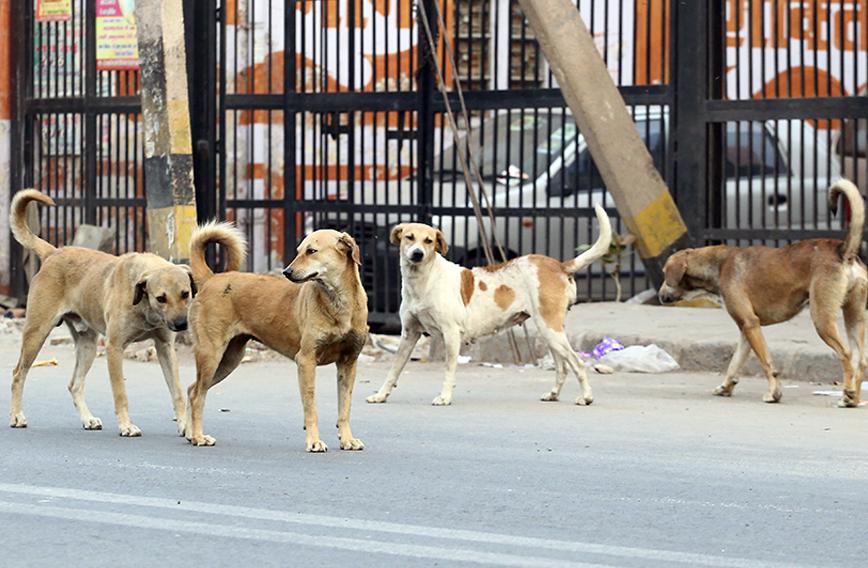
Street dogs: More kids die as the stray population grows
Umesh Anand, Gurugram
WHY are innocent children being mauled and even killed by stray dogs? What statistical threshold has been crossed for such reports to be now coming in with worrisome regularity? Is the stray dog problem across India spinning out of control? Are we in the throes of a public health crisis involving attacks, bites, rabies and deaths?
These questions arise from a series of incidents which have been reported in the media and are the only real public record of the street dog problem. In the absence of a verifiable census exact numbers are not known. But it would seem that the attacks are the result of a rapidly rising population of strays. There seems to be less space in congested cities to avoid run-ins between humans and dogs.
Between February and April this year there were at least 13 attacks, the most brutal among them involving children, who couldn’t be rescued in the heat of the moment when the attacks took place.
Even as we were putting together our list, in came one more incident reported by NDTV. An 11-year-old boy was mauled to death at the Shastri Nagar College Grounds in Uttar Pradesh’s Maharajganj. He was going from his home to a local market when he ran into a pack of stray dogs, according to the report, which quoted the police. The boy’s face and right arm were bitten off, the police said, as he seemed to put up some resistance.
 In Chhattisgarh, dogs mauled a five-and-a-half-year-old girl. She was the child of labourers working nearby. Passers-by who rushed to her rescue could not save her on time.
In Chhattisgarh, dogs mauled a five-and-a-half-year-old girl. She was the child of labourers working nearby. Passers-by who rushed to her rescue could not save her on time.
In Telangana, a boy aged five, was killed in Khammam district. He was mauled and couldn’t survive. And it wasn’t just in a district, but in Hyderabad too where a death occurred when a four-year-old boy was killed by stray dogs, prompting the high court to pull up the municipal administration over the measures it was taking to control stray dogs.
In Lucknow, inside the compound of an apartment building, a 13-year-old was pounced upon by strays and bitten. He was fortunate to be saved. But he had to be taken to hospital for his wounds and given anti-rabies injections.
The boy was quoted in The Times of India as saying that he tried to run away but one of the dogs jumped on him and knocked him down. In the melee, before other residents came to his rescue, hearing his cries for help, he was bitten in four places.
In New Delhi’s Vasant Kunj area, two brothers, aged seven and five, were killed in a wooded part of the colony within a span of two days. They lived in local shanties and belonged to poor families. Both incidents are said to have occurred when the boys had ventured out on their own.
There have been innumerable attacks on adults as well. The most recent being a CCTV record of an elderly man being attacked and killed by dogs on the Aligarh Muslim University (AMU) campus while out on a morning walk.
The street dog population, it would appear, is sizable. There are estimates that say it is in millions but it could well be in tens of millions. It is also clear that the current ways of dealing with street dogs, formulated some 20-odd years ago, have not worked. The idea that dogs at street level can be sterilized, vaccinated, fed and finally adopted doesn’t seem to have borne results because the numbers have continued to go up.
Municipalities, on the other hand, have neither the resources nor the expertise to deal with so many dogs, especially so because of the present set of rules under which dogs have to be picked up and put back at the same locations even if they have been attacking people or killing children.
A new set of rules drafted by the Animal Welfare Board stipulates that resident welfare associations (RWAs) are duty bound to designate feeding spots and look after street dogs, finally turning them into ‘community dogs,’ doesn’t seem to have much chance of working either.
First, a good many RWAs exist only in name. Secondly, RWAs have enough to do ensuring basic municipal services without having to take responsibility for street dogs. The rules don’t take in account the many people who may not like dogs and wouldn’t want them hanging around in the streets or near their homes.
Animals should be treated with kindness. Given love and affection, animals are known to respond. But such equations tend not to work in the wild or unstructured urban situations. When it comes to stressed-out stray dogs on the streets of cities, the possibility that millions of them will be transformed through adoption and bestowing love on them appears remote. It is a statistical impossibility because of the huge numbers.
Can governments and courts, where citizens go for justice, continue ignoring these realities even as the problem appears to get worse and further out of control?
The increasing number of incidents show that such attacks are widespread and not limited to any single part of the country. In fact, the way they happen indicates that they don’t seem to be preventable any longer. The feeding of dogs appears to make them more aggressive and competitive instead of calming them down and restricting them to locations. Incredibly, dogs which may attack and kill can’t be removed from the very areas where such incidents have happened. Since these are strays, they mostly can’t even be identified.
It should be noted that several of the deaths are of children from poor families. This could be because they were unattended at the time. It could also be the reason why the problem is not taken up with the seriousness it deserves.
When it comes to dogs, the poor don’t have a constituency to speak for them. In contrast, animal rights activists are well-funded and organized. Incredibly, they appear to show no remorse for the deaths of children while defending the rights of dogs to be on the streets.
As incidents mount, an urgent way out of the mess is clearly needed. The original case seeking to take dogs off the streets was filed more than 20 years ago and is still the basis for litigation that has reached the Supreme Court. Something quicker will be an act of kindness to dogs and humans alike.
Comments
-

Amit K Bose - May 7, 2023, 2:25 p.m.
Reading your opinion edit I was reminded of a report late in May 1985 in south Indian newspapers about the menace around Udhagamandalam, created by local dogs turning feral and developing a taste for human flesh. Briefly, the report said, that in 3 or 4 outlying villages in the Nilgiris, dogs had taken to the peripheral scrub jungle, hiding in it all day and coming out at dusk to hunt children & the weak, dismembering and dragging their remains back into cover. The authorities organized squads to shoot the dogs. A good number were killed… It fuelled my imagination to write a short story, The News Report. Finding that after nearly 40 years the matter has turned topical all of a sudden, I offered it to an online publisher and they very promptly published it 2 months ago: https://www.kahaanikoncerti.in/the-news-report/ So much to say that the 'menace' of stray dogs won't go away if we treat them as stray cats, cows, rats or for that matter any other vermin. Dogs were bred over centuries from wolves to become "man's best friend", more literally most obedient servant. For that to happen they needed to -- more than love in the form of scraps of food -- believe in the benign supremacy of a human master, replacing their wolf pack leader. Someone they could express their undying loyalty and subservience to. In the evolved modern day neighbourhoods defined by high rises, gated communities and a constant flow of migratory working people there are few human 'constants' left, with whom the local strays can identify with to remain loyal or grounded. As a result, behavioral atavism has taken over in few instances and they have gone back to a primal existence where a pack comprised stability and the leader to express loyalty would be the most dominant among them. Look at the sites all over India where these incidents are being reported and we will see a pattern of this insecurity emerging. The problem has been around for long. I believe it is taking on such proportions because the uniqueness of the dog as simply just not any other animal is being overlooked.
-

Siddharth Jain - May 4, 2023, 12:28 p.m.
It is the apathy, mindless ego and political stubbornness of certain politician who wants to stay relevant no matter how it affects the community, education etc. Cruelty to animals should be punishable and stopped. But when it comes to education , rat experiments where replaced by flowers as if animals and flowers have same anatomy. Dogs who are biting and eating out kids as prey should be tolerated. Why? Just because some politician had found this way of starting important and relevant . Not only Eaten by dogs is issue .... Number of dog bites per day have increased everywhere. If children or adults don't get timely treatment they run the risk of dying from rabies. Then who will be responsible for that ..nothing can be done to take away dogs who is known to cause trouble as per law.. that's insanity .. sadly prevails in front of us. If your child, mother or father are bitten by a street dog for no reason, it is very obvious that such a menace should be taken away.. dog lovers can protect those which live in the community without troubling .





